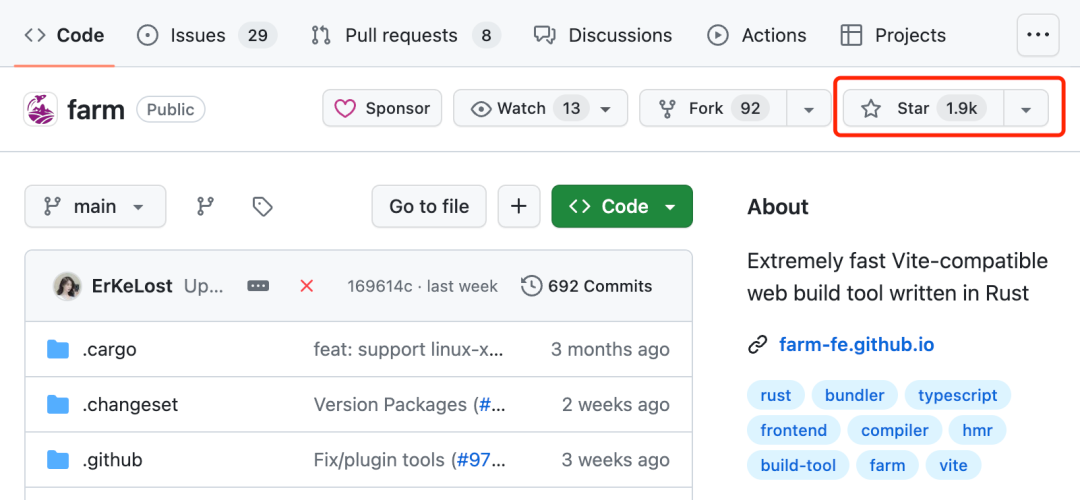In 2024, Rust is becoming more and more popular
On February 19th, Rust released its 2023 survey report. This survey has been conducted continuously for eight years, attracting many maintainers, contributors, and people interested in the future development of Rust projects to participate.
The 2023 Rust Status Survey began on December 18, 2023 and will continue until January 15, 2024. The Rust team is exploring a more efficient and sustainable process to collect and analyze data faster, providing deeper and more valuable insights to the community.
# Rust Usage
In 2023, the proportion of respondents who identify themselves as Rust users will increase slightly, from 91% in 2022 to 93% in 2023.

Among the population using Rust in 2023, 49% are using Rust every day, an increase of 2 percentage points compared to last year, showing a slight upward trend.

Among respondents who were non-Rust users , 31% said the difficulty of Rust was the main reason they didn’t use it, while 67% noted that they haven’t had the opportunity to prioritize learning Rust, which remains the most common reason they don’t use Rust.

Among former Rust users surveyed in 2023, 46% said they stopped using Rust due to factors beyond their control (down 1 percentage point from 2022), 31% gave up Rust due to a preference for other programming languages (up 9 percentage points from 2022), and 24% cited difficulty as the main reason they gave up Rust (down 6 percentage points from 2022).

In the past year, the level of Rust skills among respondents has generally improved! 23% of people can write simple Rust programs (a decrease of 6 percentage points compared to 2022), 28% of people can write code that can be used in actual production (an increase of 1 percentage point), and 47% of people believe that they are quite efficient when using Rust - this proportion has increased from 42% in 2022. Although this survey is only one of many tools to measure changes in Rust skill levels, these numbers are still encouraging because they reflect the increasing knowledge and skills of Rust users who participate in the survey year after year.

From the perspective of the operating system used by Rust users, the current situation is roughly the same as the survey results in 2022. Linux is still the most popular choice among Rust users, followed closely by macOS and Windows, with similar usage rates among the three.

While Linux machines remain the favorite platform for Rust programmers, they are also developing Rust programs for a variety of other platforms. Notably, the number of users for WebAssembly, embedded, and mobile platforms has increased slightly, further highlighting Rust’s Cross-Platform Capability.

From the current situation, Visual Studio Code seems to still be the most popular editor among Rust developers, and RustRover, launched last year, has also won the favor of many developers.

# Rust work
The trend of using Rust in work continues to rise year by year. In the 2023 survey, 34% of respondents said they use Rust for most of their coding work, an increase of 5 percentage points from 2022. Among this group, 39% of people’s organizations have a significant application of Rust.

It is worth noting that the top reason for employers to invest in Rust among respondents is still the ability to build relatively accurate and defect-free software, accounting for as high as 86%. This proportion has increased by 4 percentage points compared to the survey results in 2022. Rust’s performance characteristics ranked second, accounting for 83%.

We are also pleased to see that 79% of respondents stated that Rust has helped their company achieve its established goals, an increase of 7 percentage points compared to 2022. In addition, 77% of respondents expect their organization to continue using Rust in the future, an increase of 3 percentage points from the previous year. It is worth mentioning that the proportion of respondents who believe that Rust is challenging for their organization has decreased, from 34% in 2023 to 39% in 2022. At the same time, the proportion of respondents who believe that Rust’s investment value for money has also increased, from 60% in 2022 to 64% in 2023.

The formation of this trend is influenced by various factors, but the continuous improvement of Rust’s popularity may have led to the abundance of resources, which in turn provides better support for new teams using Rust. In terms of technology, Rust has shown obvious advantages in building server backends, web and network services, and cloud technology, and has been widely welcomed.

# Rust Challenge
The Ruts team has been working to reveal the challenges, concerns, and priorities Rustaceans have faced throughout the year through the Rust Status Survey.
Among the 9,374 respondents who shared their concerns about the future of Rust, we noticed that the majority (43%) are concerned that Rust will become too complex, an increase of 5 percentage points from 2022. In addition, 42% of respondents are concerned about the insufficient popularity of Rust in the technology industry. It is particularly noteworthy that in 2023, 32% of respondents are most concerned that Rust developers and maintainers will not receive sufficient support, an increase of 6 percentage points from 2022.
It is gratifying that the proportion of respondents who are not worried about the future of Rust has significantly decreased, from 30% in 2022 to 18% in 2023.

The features that Rust users want to implement, stabilize, or improve are mainly in the following areas: features (such as trait aliases, associated type defaults, etc.), constant execution (such as generic constant expressions, constant attribute methods, etc.), and asynchronous programming (such as asynchronous closures, coroutines, etc.). These areas are all important areas of improvement that the Rust community is currently focusing on and expecting.

It is worth noting that 20% of respondents said they hope Rust can slow down the development of new features, which is likely related to the concerns mentioned earlier about Rust becoming too complex.
From the survey results, it seems that Rustaceans are most likely to encounter challenges in asynchronous Rust, feature and generic systems, and borrow checkers. These areas require more support and improvement to meet the needs and expectations of the community.

The respondents who participated in the survey expect Rust maintainers to mainly focus on the following aspects: the top priority is to fix vulnerabilities in the compiler (68%), followed by improving the runtime performance of Rust programs (57%) and improving compile time (45%). Improvements in these key areas will help improve the overall quality and User Experience of Rust.

Similar to the situation in recent years, respondents generally believe that compile time is one of the key areas that urgently needs improvement. However, it is worth noting that respondents seem to value the importance of runtime performance more when weighing runtime performance against compile time. This indicates that optimizing runtime performance is also an important issue of concern in the Rust community.
So the question is, will you embrace Rust?































